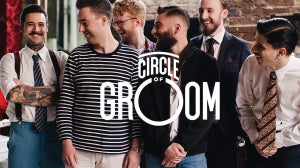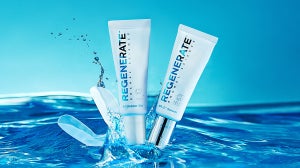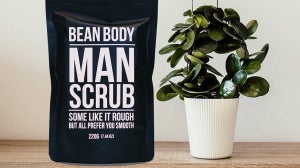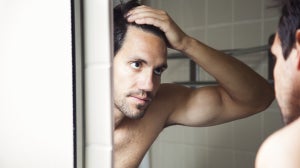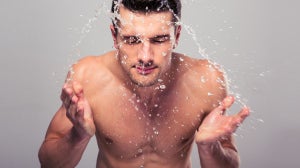
Men's haircare is an incredibly diverse topic, and frankly, one we could talk about all day. We've written at great length in the last year about various haircare related topics, giving a detailed account of the types of products currently on the market, we've talked you through the Buzz Cut and the Short Back and Sides, even covering how often you should wash your hair. As part of our Groom 101 series, we're taking it right back to basics, giving you an overview of everything you need to know about haircare for men.
The Complete Guide to Haircare for Men

Shampoos, Conditioners, and Treatments
Strong, healthy hair is built on the foundation of a good haircare routine. Unless you're one of small minority who belong to the controversial #nopoo movement, who do away with washing the hair altogether, this routine should start with your shampoo.
Shampoo
All shampoos clean away dirt, grease, and pollution from the hair, but beyond this core function, shampoos come in a number of varieties. Some shampoos contain a greater level of cleansing agents, which is beneficial for for those who wash infrequently, or who have naturally oily hair.
Others are much gentler, containing fewer cleansing agents, or in a few cases none whatsoever. These create a lesser degree of lather, which is less likely to cause irritation for those with sensitive skin, and less likely to strip moisture and nutrients from those with damaged, coarse, or dry hair.
Many shampoos come with additional conditioning agents to impart a range of other benefits. Those with hair which has been damaged from chemical treatments, heat, or dyeing can make use of a dry hair shampoo, for example. Fine hair often gets particularly greasy, which means traditional conditioners can feel too heavy, but is left lifeless by harsh shampoos. Conditioning shampoos are great if this applies to you.
Conditioner
Conditioner is particularly important for those with coarse or dry hair, but should form a part of any man's hair routine. Almost inevitably, shampooing strips away some vital nutrients and moisture from the hair and scalp, and conditioner helps to replace this, ensuring your hair is strong and healthy. For those with fine or greasy hair, conditioning infrequently or even before shampooing can ensure you're getting the benefits without experiencing the downsides to the same extent.
Hair Treatments
Hair treatments come in a number of varieties, usually addressed to a specific haircare concern. If your hair is thinning, receding, or very fine, a treatment that focuses on giving body and fullness is a great way to get the most out of your hair. Those with coarser, dryer hair may benefit from a hydrating treatment such as a hair mask. Scalp scrubs help to slough away dead skin on the scalp, both combating dandruff and helping to speed up the process by which skin cells are regenerated.
For those concerned at the level of hair loss they are experiencing, a variety of Hair Loss Treatments exist, which use a variety of methods to preserve hair, make the most of what's left, and in certain cases, even go some way to reversing hair loss.
Hair Styling for Men
What will work best for you when it comes to hair styling will largely be determined by your hair type, but for most men with short hair, if it's straight, wavey, or even curly, some form of the following 3-step method will be the ideal way to create the style you want and lock it in place.
Step 1: Use a Pre-Styler - Used to create fullness, body, and pliability in the hair, the main types of pre-styling products are thickeners, volumisers, and sea salt sprays. For additional volume and lift, apply a pre-styling spray to wet hair before blow drying. For certain styles, mousses, styling pastes, and even hair gels can be used in this way in place of a pre-styler.
Step 2: Styling product - Strength of hold, level of shine, and remouldability are the three main factors that come into play in styling products. Hair clays typically have high hold and a matte finish, while pomades and creams tend to have higher shine and lower hold, but products with all combinations of properties exist.
Step 3: Use a finisher - To sum up, once your desired style has been created with a styling product, you can lock it in with a quick application of a hairspray. Hairsprays don't create style in themselves, but when applied to already styled hair, holds it in place to prevent it from losing its shape throughout the day.
What hair type am I?
The key to figuring out what products you need as well as what hairstyles will work best for you is understanding your hair type. Your hair type will usually be a combination of the following:
Fine - Fine hair and thin hair are often mistakenly rolled into one, but the terms actually describe quite different problems. You have fine hair if your individual hair strands are fine, rather than if you have hair which is receding or falling out due to male pattern baldness or other reasons. Those with fine hair quite commonly have more individual hairs than those with thicker hair strands, especially if it's also fair.
Problems common to fine hair include greasiness, and the hair appearing thin under light. For this reason, matte products are nearly always advisable, unless you're Tom Hardy and can get away with it (see below), as pomades and gels can cause clumping, a visible scalp, and excessive greasiness.
https://www.instagram.com/p/BqXubmTHaXM/
Your hair appearing flat can also be a common problem. Using a thickening spray with a high hold product like a clay, as well as not shying away from lift and volume when choosing your style, can help to combat this.
Coarse - if you have thicker individual hair strands you'll usually have a completely different experience with hair styling. Typically, if you have coarse hair, it will be thinner, and therefore relatively easy to style and manage. Products with medium hold will usually do a decent job of creating enough lift and volume to style your hair.
Problems you may encounter include it looking frazzled or dry. You can get around this by using a styling product with natural oils and conditioning agents, like hair creams or pastes. These help to give coarse hair a moisture boost, and in low quantities, impart a healthy-looking shine. As well as this, sticky products like many waxes, fibres, and clays, may cause your hair to clump together and become unmanageable, and therefore should be avoided.
Thick - while many men long to get thicker hair, it does come with a few downsides. Thick hair typically speaking gets greasier a little quicker, and more crucially, can be harder to style. This is why your barber may offer to 'take some of the weight out' when you get a haircut. Thicker hair tends to droop throughout the day, and it can be difficult to create bigger, voluminous looking styles. Using a pre-styler for additional pliability, and applying a high hold product such as a wax or clay, emphasising applying at the roots, will go some way to beating this.
Those with thick hair quite often become perfect candidates for certain haircuts that time forgot, such as the M-shaped fringe, or a longer brush cut. Deployed intelligently, this can be a distinctive, stylish, and relatively low-maintenance option. See Timothée Chalamet for a look embodying a hybrid of the two.
https://www.instagram.com/p/BbnXLrZBjyL/
Thin - if your hair is naturally thin, or you're affected by hair loss in some way, then your main haircare concern will most likely be trying to create the appearance of volume and thickness. This is an easy process with a few products at your disposal.
Regularly using hair thickening treatments such as Serioxyl from L'Oreal Professionnel, nutritive hair masks and scrubs, and anti-thinning shampoos will make sure you're starting from the strongest foundation possible when it comes to styling.
Matte finish styling products will ensure your scalp isn't overly visible, and by absorbing light, will create the visual impression of fullness. Volumising powders and thickening sprays will help to boost the thickness of the hair by binding to the root, adding body.
Straight - straight hair is usually fairly manageable and easy to style, at least up until a certain length. The main problem encountered by those with very straight hair is that it's sometimes difficult to create textured looks, and certain hair products can create an unwanted spiky effect. Using a sea-salt spray before styling can help with this, as can using a natural finish styling product like a thickening paste or clay.
Another method for this that may be useful is to grow your hair out a little longer than you usually would. Before styling, apply a mousse or sea-salt spray to your damp hair to add body and texture, and use a blow dryer with a barrel brush to create slight waves.
Wavy - hair with a slight curl is perhaps the easiest to style in different ways. Blow drying wavy hair while combing it will usually straighten out waves without taking up too much time, while the natural texture of your hair will make creating all kinds of looks easier.
Curly - if your hair is particularly curly, your options for styling will be more limited, but you still have plenty to work with. Products with a sticky texture will usually not work very well in curly hair, so it's worth steering clear of many waxes, as well as most fibres, putties, and clays.
Products with a lower hold such as hair creams and pomades will sidestep this problem but may not provide the kind of hold needed to add shape to the hair. A solution for this is a hair paste such as the Aveda Thickening Paste or the Goldwell Stylesign Texturiser. When first applied, these products render your hair pliable and easily styled, but quickly evaporate to leave a completely natural finish that won't cause unpleasant stickiness.
Tightly curled/Afro - very tightly curled hair usually has the advantage of having natural body and lift, but can be difficult to manage meaning the most effective way to style it is by cutting the hair into the desired shape. Close cropped styles such as buzzcuts and crew cuts are low maintenance and effective, while a fade with medium length on top is a fantastic look.
https://www.instagram.com/p/BsYPhV_AI49/
Whether you keep tightly curled hair short or grow it out longer, it's usually wise to avoid any hair products with any kind of stickiness whatsoever. Hair creams are the perfect solution, allowing you to tame flyaways and create shape without negative effects.
-
Here at Mankind, we take haircare very seriously, and when we said at the start of the post that we've covered hair care in plenty of detail over the last year, we weren't joking. Read more of our haircare related blogs below:
As always, for more male grooming expertise, keep up to speed with the Mankind blog.

